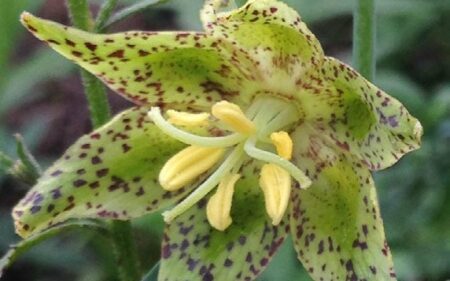The Fab Five: Unique Native Plants You’ll Want to Consider
1. Perfect for a container: Cliff Maids (Lewisia spp. and hybrids)
There are several species of Lewisia native to California, mostly but not exclusively occurring in Northern California and the Sierras. The plants are short rosettes of foliage with colorful flowers in shades of pink to yellow and white. Although many of the available varieties are likely hybrids with a lineage of mixed species, most cultivated plants most closely resemble and are often labeled as Lewisia cotyledon.
This beautiful and tough succulent perennial makes a wonderful container plant for a patio or balcony. When planting it, amend your potting soil with lots of gravel or pumice for exceptional drainage. You will also want to water these sparingly. Think about how often you would water a cactus and follow a similar regime. The fastest way to kill cliff maids is giving in to the temptation to water them too often or by using potting soil that holds too much water. If you want to grow them in the ground, create a rockery or a crevice garden for alpine plants. To do this, pack gravel between larger stones with just a little compost and soil mixed in.

2. A long bloomer: Bush Sunflower (Encelia californica)
A central coast and southern California local, the bush sunflower is a joyful perennial. It can be found in coastal sage scrub while walking to the beach, or on a hike up into the foothills. In a dry year, the bloom is fabulous but short-lived. In areas where they can catch fog drip or some type of water flow, the bloom continues into fall. As seeds mature, watch for songbirds that come in for a feast.
This plant is a great beginner plant for native plant gardeners or for those looking to add some cheer to an existing landscape. With a little supplemental water and light deadheading through summer, these plants will keep pumping out flowers. If you prefer to garden on the dry side, you can let them go summer dormant. In the fall, or when you feel like it’s looking a little out of bounds, they can be whacked back to 6” and they will rebound for the next year. Next time you see one in bloom, stop to smell the flowers, some say they smell like chocolate.

3. Beauty for Shade: Spicebush (Calycanthus occidentalis)
One of three species, all known as spicebush or sweet shrubs, have a warm fragrance from bruised bark, leaves, or flowers. Our native species of Calycanthus can be found in northern California and the Sierras. The others, C. floridus and C. chinensis, grow in the South-Eastern USA and China as their scientific names suggest. The large deciduous leaves are beautiful in summer and turn a gorgeous gold in fall. Unusual star or lotus-like flowers are sporadic through summer and into early fall.
To keep this beauty happy, it will want supplemental water through summer. It will also tolerate shade and sun. It looks especially good against ferns or scarlet monkeyflower (Erythranthe cardi nalis) who would thrive with a similar climate and irrigation regime. If it is getting out of bounds, no worries, this plant responds well to being cut back to the ground in fall. With any hard pruning, it is worth keeping in mind that you may miss flowers the following season. Give this shrub a little space, it will spread modestly but not aggressively through suckers.

4. Unusual Form: Cliff Spurge (Euphorbia misera)
Relatively rare north of the Baja border where it occurs regularly, cliff spurge can be seen around San Diego and on some of California’s Channel Islands. This coastal and Sonoran Desert native has an architectural form; rubbery silver-grey stems arch gracefully and are adorned with small round leaves and long-lasting, miniature but colorful flowers.
This plant is perfect for a collector of the unusual. It could be displayed decoratively in a pot or used repetitively with a few other plants in a simplified pallet for a modern take on a native landscape. This plant will thrive with little supplemental water but it may go summer dormant without. As with all euphorbias, take some caution with placement. If you are pruning, be careful as the white milky sap may irritate the skin and eyes.

5. One for the Bugs: Buckwheat (Eriogonum spp.)
The buckwheats are a huge group of plants with over 100 species and varieties occurring throughout California. Lifeforms of these plants range from annual herbs to substantial long-lived shrubs. A few locals include California buckwheat (E. fasciculatum), ashyleaf buckwheat (E. cinereum), and sea cliff buckwheat (E. parvifolium). Other regular crowd-pleasers at The Garden come from California’s Channel Islands include red-flowered buckwheat (E. grande var. rubescens) and St. Catherine’s lace (E. giganteum var. giganteum).
They all have clusters of tiny flowers giving the overall inflorescence a fuzzy appearance in bloom. Flower colors range from white to dark pink, with a handful of species showing neon yellow and acid green. On most species, aging flowers turn rusty brown maintaining ornamental structure. Speaking of the flowers, buckwheats are usually a buzz when in bloom so plant a few for our native bees. Be sure to research individual species, but most want sun and may reseed themselves in your garden. O

 Donate
Donate




